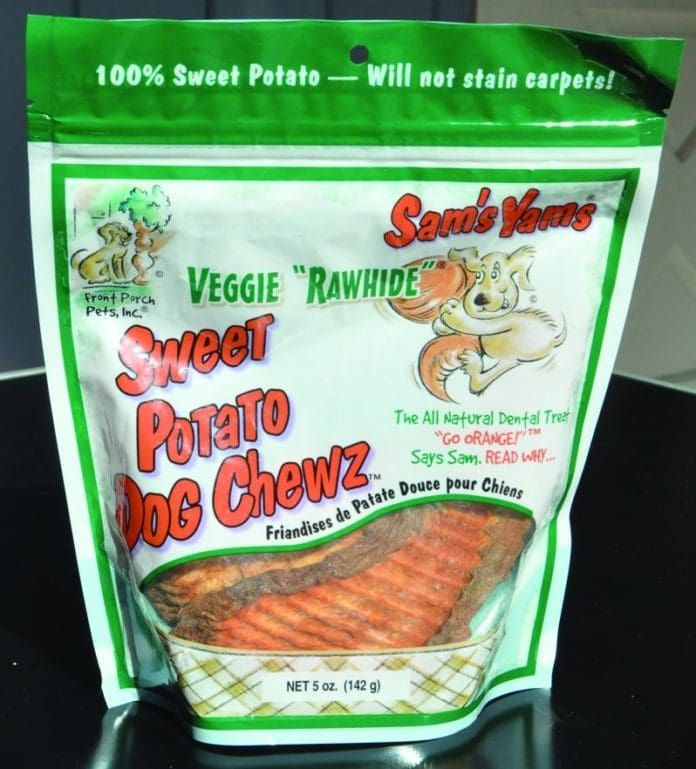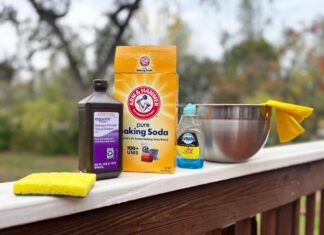[Updated March 6, 2018]
Surely there is no such person as a dog owner who never gives his or her dog a treat. We all like to see our dog’s tail wag, and his face light up with attentive anticipation, right?
But how do you know that the treats you give him are healthy? It’s actually pretty simple. As with every food you buy (for yourself or your dog), it’s all about the ingredients.
If you do not already read the label of every food item you consider buying, get in the habit! Most of the information you need to know in order to determine the product’s quality is legally required to appear on the label.
Want to throw together your own homemade dog treats? Try these homemade recipes.
What to Look for in Dog Treats
We suggest that you start with the ingredients list. Ingredients are listed on the label by weight; there is more of the first ingredient on the list present in the treat than the second ingredient, and so on. (One exception: If equal amounts – by weight – of different ingredients are present, the manufacturer can list those ingredients in any order; that is, as long as they are still in order relative to the other ingredients). The first few ingredients on the list are the most significant; since they comprise the majority of the content, they should be especially high in quality.

What constitutes quality in a pet food ingredient? Actually, the same attributes that indicate quality in human food denote quality in pet food. Top-quality ingredients are as fresh, pure, and minimally processed as possible; whole food ingredients are better than by-products or food “fractions.” For example, “wheat” is better than “wheat flour.” “Wheat flour” is better than “wheat bran and wheat germ.” The more highly processed and reconstituted an ingredient is, the more opportunities it has for adulteration and contamination, and the more nutrients it loses.
It stands to reason that the freshest ingredients available to U.S. food makers will be grown in the U.S. While some manufacturers argue that their oversight of foreign ingredient providers is reliable, we strongly prefer domestic ingredient sources. The only exception may be those ingredients that are near-impossible to obtain from U.S. sources, such as free-range, organic venison. Even so, if we found a treat that contained domestically sourced free-range, organic venison, we’d favor it over a product containing free-range, organic venison from New Zealand.
Ingredients that are sourced as close as possible to the manufacturer (locally sourced ingredients) are good. Again, they are necessarily fresher than ingredients that require shipping from across the country. That’s good for the environment, too.
Every ingredient on the label should be an easily recognizable food; there should be no question what the source is. For example, “meat meal” or “animal fat” could come from just about anywhere. In contrast, “chicken” comes from chickens, and so does “chicken fat.” If you can’t determine what species of animal a meat or fat came from, you should not feed it to your dog.

Organic ingredients are good; they are less likely to be adulterated with contaminants, and they receive extra scrutiny from inspectors. The more organic ingredients, the better.
If a sweetener is used, it should be natural and food-based, and used in moderation. Applesauce, molasses, or honey are better than artificial sweeteners. We disapprove of any sweeteners in dog food, but we’re talking about treats here: something the dog may not get every day, and something he’ll get only a few of. A little natural sweetening in a treat is okay.
If a treat is preserved, it should contain a natural preservative. Vitamins C and E (the latter is listed as “mixed tocopherols”) are effective and safe preservatives. Some treats contain no preservatives at all; these should be stored properly and used promptly.

Meaty Treats
The most obvious characteristic of a meaty treat is its high animal protein content. Animal muscle and organ meat ingredients are much more expensive than grain- or vegetable-based products, so meaty treats will generally cost more than other types of treats.
Products may be quite dry (with a moisture content around 5 percent); or chewy, with as much moisture as 25 percent. The moist products will necessarily contain ingredients known as “humectants” — substances that promote the retention of moisture in the product. The low-moisture treats may be dried, freeze-dried, or dehydrated.

1)]
In general, the fewer ingredients used in meat-based dog treat products, the better.
Cookie or Biscuit-Style Treats
In general, cookie- or biscuit-style treats are made with grain or another carbohydrate and baked. That said, this is a wide category of treats, and there are many grain-free products on the market.
Some biscuits use animal products (such as muscle meat, organ meat, fat, dairy products) as the principle palatant (ingredient used to appeal to dogs), but others use sweeteners or salt.
This style of product generally has the same range of moisture content found in dry dog foods — about 10 to 12 percent.
In general, the fewer number of least-processed ingredients used in these products, the better.

Dog Treat Ingredients to Avoid
While you are examining the list of ingredients for quality components, make sure the treat does not contain any of the following:
• Artificial preservatives, including BHA, BHT, ethoxyquin, potassium sorbate, sodium nitrate (used for dual purposes, preservative and coloring), and calcium propionate should be avoided.

• Artificial colors. Color is added to dog treats to appeal to you; your dog doesn’t care what color the treat is! You aren’t going to eat these treats, are you? So don’t buy treats that contain these unnecessary (and many believe unhealthy) chemicals.
• Chemical humectants, such as propylene glycol. These are used in some pet (and human!) foods to keep them moist and chewy, and to prevent discoloration in preserved meats. There are more natural, food-sourced humectants available, such as vegetable glycerin and molasses.
Speaking of glycerin: If it’s not identified as “vegetable glycerin” (a food-sourced product), it’s likely to be a petrochemical product – not good.

0)]
Other Admirable Traits
There are many other factors that we consider when buying treats, but these don’t quite rise to the level of make-it-or-break-it selection criteria. However, they are attributes we appreciate for their benefits to our dogs, all dogs, and the planet we all share.
• We like to see products with recycled (and/or recyclable) and minimal packaging.
• We seek out treats that are either small, or easy to break into small pieces. When you use a lot of treats for training, they should be small, so you don’t ruin your dog’s diet.
• We admire companies that simply list the ingredients in their products, without splashing the ingredients they don’t contain all over the label, as in, “No soy, wheat, or corn!” Many dogs do just fine with soy, wheat, corn, and other ingredients that some food makers try to marginalize. (Please consider that there is a difference between a label that boasts, “No artificial colors or preservatives!” and one that says, “No corn!”).

2)]
• On a related note, we get aggravated every time we see a label claim that a treat is “hypoallergenic” or “contains no allergens.” Any food ingredient can be an allergen; there are dogs who are allergic to eggs, chicken, beef, fish, pork, lamb, rice, barley, quinoa, and any other food you can name – foods that are perfectly appropriate for most dogs.
• We appreciate companies that donate a percentage of their sales to dog-related charities.
The Caloric Content of Treats
It’s long been one of my pet peeves that dog food manufacturers are not required to put the caloric content of their products on their labels. It seems that many food makers don’t seem to think that dog owners are smart enough to use this information to help determine how much their dogs should be fed in order to maintain a healthy weight. (I’m sure some aren’t, but hey! Some are!)
I applaud the pet food companies that do include the caloric content on the label voluntarily — which means the treat manufacturers that include this information should get a standing ovation.
Why should treat makers get extra credit? Because treats are, by their very definition, more desirable and delicious than regular food. And dog treat makers frequently achieve “desirable and delicious” the same way that human treat makers do: with extra fat, sugar, and salt. Fat is the worst offender in terms of adding calories; a gram of fat contains about 9 calories. In contrast, a gram of carbohydrate or protein contains about 4 calories. Salt, of course, is noncaloric.
However, the more palatable a treat is, the more a dog will want it, and the harder he will work to get you to give him more than he really should receive.

4)]
“No problem!” some people say. “I’ll just reduce how much of his food I’ll give him!” He may need to have his total food intake reduced a bit anyway, but in general, it’s a bad idea to replace more than about 10 percent of his nutritionally “complete and balanced” diet with a decidedly not complete and balanced food (some vets suggest no more than 5 percent of his diet). Few treats are formulated with vitamins and minerals in the proper amounts and ratios, based on their calorie content, to represent a properly “complete and balanced” contribution to your dog’s diet. If incomplete and unbalanced treats replace a significant portion of his complete and balanced diet, it follows that your dog won’t receive all the nutrients he needs.
So, how much should you feed your dog, and how will treats affect that? As author Mary Straus explained in “Helping Your Dog Lose Weight,” “Resting energy requirement (RER) is the number of calories per day your dog requires for just basic needs . . . To determine your dog’s RER, convert his ideal weight in pounds to kilograms by dividing by 2.2, then multiply that number by 30 and add 70.”
For example, for my dog Otto, I would use 65 pounds as his ideal weight. I divide this by 2.2 (which is 29.54 kg). Multiplied by 30 plus 70 is 1,026.36 calories — Otto’s RER. I want to make sure that no more than 10 percent (rounding a bit, 103 calories) of these calories are treats.

5)]
Well, Otto’s favorite treat is hot dog, and the ones I buy to use for his training treats contain 130 calories per hot dog. Yikes! When we go for a walk or to a training class, I generally bring two hot dogs. I cut them into many tiny pieces, but still, on these days, he’s getting more than 25 percent of the calories he should be eating in one day from an extremely unbalanced and certainly incomplete food.
So, why isn’t Otto hugely fat — or showing the signs of nutritional deficiencies? To answer the former, on the days when we walk or train, he gets a lot more exercise — enough to burn off the extra calories. As to the latter: I’ve only had him for a year and a half — and he certainly doesn’t get two hot dogs every day! But I should definitely adjust this treat habit — start mixing in some lower-calorie treats, and saving the really fatty hot dogs for just the most difficult behaviors I want to reward — before it results in health problems brought on by nutritional deficiency.
These are the sort of things you should be considering when you make treats a regular part of your dog’s diet. Do the math; it’s not that difficult! And look for the caloric content on the label of your favorite treats. If it’s not there, check the company’s website, or call them and ask. If they can’t give you the information, don’t buy that treat! It’s my basic information that they should know and be willing to share.
Our List of Approved Treats
We’ve listed a number of companies that make treats that meet all of our selection criteria. Be aware that we do not rate or rank-order the treats we have highlighted as examples of good products. A treat either meets our selection criteria (as outlined above) or it does not; there is no “top pick” or “best on the list.” We suggest that you try a variety of products, and keep track of which types your dog likes best and which don’t agree with him (so you can avoid them in the future).
Don’t fret if your top pick is not on our list; if it meets our selection criteria, it’s as good as anything we’ve highlighted below. Happily, there are many more good products on the market than we could ever list!

Top-Quality Meaty Dog Treats
Meaty treats vary quite a bit in consistency, since some are dried and others are dehydrated or baked. Also, some contain only meat: others contain grains or other carbohydrates on the ingredients list (below the meat ingredients).
BELLYRUBS DOG TREATS
Meyer Country Farms
Scottsdale, AZ
(480) 614-1869

3)]
CANINE CAVIAR
Canine Caviar Pet Foods, Inc.
Costa Mesa, CA
(800) 392-7898
CARNIVORE CRUNCH
Stella & Chewy’s
Muskego, WI
(888) 477-8977
DR. BECKER’S BITES
Dr. Becker’s Bites
St. Anne, IL

ETTA SAYS! MEATY TREATS
Etta Says!
Seattle, WA
(866) 439-3882
GRIZZLY NUTREATS
Grizzly Pet Products, LLC.
Kirkland, WA
(888) 323-5575
L1V-A-LITTLES
Halo Purely for Pets
Tampa, FL
(800) 426-4256
MEATY BITES
Addiction Foods, NZ Limited
Te Puke, New Zealand (U.S. distributor is Evergreen Pet Supply)
NOTHING BUT…TREATS
A Place for Paws
Columbiana, OH
(800) 354-4216
PRIMAL DRY ROASTED TREATS
Primal Pet Foods, Inc.
San Mateo, CA
(866) 566-4652
WELLNESS PURE REWARDS AND WELLNESS WELLBITES
Wellpet, LLC., Inc.
Tewksbury, MA
(800) 225-0904
WHOLE LIFE PET TREATS
Whole Life Pet Products
Pittsfield, MA
(877) 210-3142
ZIIMPEAK GOOD DOG TREATS
Ziwipeak Ltd.
North Island, New Zealand
(877) 464-9494
ZUKE’S TREATS FOR DOGS
Zuke’s
Durango, CO
(866) 985-3364
Top-Quality Cookie Treats

7)]
Cookie- or biscuit-style treats tend to have a more consistent texture, thanks to their baked carbohydrate content. But because the dough can be rolled and cut out, bakers can design an unlimited number and variety of creative shapes and sizes. As cute as the larger cookies are, we strongly prefer small treats – or at least cookies that can easily be broken into hits.
BARKSTIX
Bark Stix
Pt. Richmond, CA
(510) 235-2430
BUDDY BISCUITS, MUTTOS, PROVENANCE, TRAILHOUND
Cloud Star Corporation
San Luis Obispo, CA
(800) 361-9079

CHARLEE BEAR DOG TREATS
Charlee Bear Farms, Inc.
Madison, WI
(800) 980-2327
FRUITABLES
Vetscience, LLC.
Dallas,TX
(214) 800-2321
GRANDMA LUCY’S DOG TREATS
Grandma Lucy’s
Irvine, CA
(800) 906-5829
HOWLIN’ GOURMET
Dancing Paws Bakery
Tustin, CA
(882) 644-7297
MA SNAX SUPERIOR TREATS
Ma Snax
Sonoma, CA
(707) 9398174
MOTHER NATURE NATURAL DOG BISCUITS
Natura Pet Products
Santa Clara, CA
(800) 532-7261
NEWMAN’S OWN PREMIUM DOG TREATS
Newman’s Own Organics
Aptos, CA
(800) 865-2866
PAWS GOURMET
Paws Gourmet, Inc.
Marysville, WA
(866) 231-7297
SMOOCHES, NUZZLES, and PECKS
The Honest Kitchen
San Diego, CA
(866) 437-9729
SOJOS DOG TREATS, GOOD DOG TREATS
MONZIE’S ORGANIC COOKIES FOR DOGS
Sojourner Farms
Minneapolis, MN
(888) 867-6567
TOY TEMPTATIONS
Dogchewz NYC
New York, NY
(212) 722-5855
WAGATHA’S BISCUITS FOR DOGS
Wagatha’s
Manchester Center, VT
(802) 367-1010

6)]
WAGGIN’ TAILS COOKIES
Waggin’ Tails Bakery
Santa Rosa, CA
(707) 569-9425
WET NOSES HERBAL DOG TREATS
Wet Noses Dog Food Co.
Snohomish, WA
(866) 938-6673
Another Sort of Treat

These two treats are not meat-based but they are not cookies. either! Both contain a single-ingredient: Dried sweet potato.
DR-CHEW SWEET POTATO TREATS
Landy Corporation
Federal Way, WA
(253) 835-1427
SAM’S YAMS
Front Porch Pets, Inc.
Henderson, NV
(800) 922-2968
DOG TREATS: OVERVIEW
We make it a point to say this every single time we discuss treats: Don’t buy dog treats at the grocery store, unless you also do each of the following:
1. Read the ingredients panel of any treat you consider buying. Pass it by if it contains artificial preservatives and/or colors, animal products from unnamed species, or animal by-products.
2. Check the ingredients list for foods your dog may be allergic to or intolerant of.
3. Don’t forget that you can use real, fresh food for treats! Offer your dog bits of cheese, cooked meat, and pieces of fruit and vegetables, and determine which he likes best.







My wife and I are planning on adopting a dog soon, and we want to make sure that we pick out the right treats. It was really helpful when you mentioned that it is a good idea to start with the ingredients list when looking at treats. It seems like it could be a good idea for us to pick dog treats that are made without any GMOs. https://treasurestatetreats.com/shop